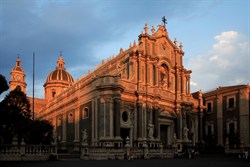The Cathedral
 Another symbol of the post-earthquake reconstruction of Catania and of Vaccarini‘s mastery is undoubtedly the Cathedral. The original temple which was built in the eleventh century, was destroyed several times by fire and natural disasters. After the earthquake of 1693, it was almost completely rebuilt. The interior has a Latin cross plan, with three naves. In the right nave there is a painting by BorremansGuglielmo Borremans (1672-1744) was a Flemish painter, born in Antwerp. His fame, however, is linked mainly to Italy, where he spent most of his life, especially in Naples and Sicily. His most famous works are kept in various museums and churches on the island. on the first altar, the tomb of the musician Vincenzo BelliniBorn in Catania, Vincenzo Bellini (1801-1835) is one of the greatest and most famous Italian opera composers of the nineteenth century. Among his works are Norma, La Sonnambula (The sleepwalker), La straniera (The foreigner) and I Puritani (The Puritans). He is buried in the cathedral of Catania. and, above all, the majestically decorated chapel, dedicated to Saint Agatha. Inside, a golden door gives access to the underground chamber where the reliquary bust of the saint and the casket with her remains are kept. The are five altars in both naves, each decorated with paintings of great artistic value, while the high altar, in the centre, in the Norman style, is surrounded by a wooden choir of the late sixteenth century by the Neapolitan sculptor Scipione Guido. The altar is in polychrome marble and has a silver base over it, on which the reliquary bust of Saint Agatha is placed in the course of the festivities in his honour. At the center of the apse, a large single-lancet window dating from the twelfth century recalls the medieval origins of the cathedral, although the glass is more recent.
Another symbol of the post-earthquake reconstruction of Catania and of Vaccarini‘s mastery is undoubtedly the Cathedral. The original temple which was built in the eleventh century, was destroyed several times by fire and natural disasters. After the earthquake of 1693, it was almost completely rebuilt. The interior has a Latin cross plan, with three naves. In the right nave there is a painting by BorremansGuglielmo Borremans (1672-1744) was a Flemish painter, born in Antwerp. His fame, however, is linked mainly to Italy, where he spent most of his life, especially in Naples and Sicily. His most famous works are kept in various museums and churches on the island. on the first altar, the tomb of the musician Vincenzo BelliniBorn in Catania, Vincenzo Bellini (1801-1835) is one of the greatest and most famous Italian opera composers of the nineteenth century. Among his works are Norma, La Sonnambula (The sleepwalker), La straniera (The foreigner) and I Puritani (The Puritans). He is buried in the cathedral of Catania. and, above all, the majestically decorated chapel, dedicated to Saint Agatha. Inside, a golden door gives access to the underground chamber where the reliquary bust of the saint and the casket with her remains are kept. The are five altars in both naves, each decorated with paintings of great artistic value, while the high altar, in the centre, in the Norman style, is surrounded by a wooden choir of the late sixteenth century by the Neapolitan sculptor Scipione Guido. The altar is in polychrome marble and has a silver base over it, on which the reliquary bust of Saint Agatha is placed in the course of the festivities in his honour. At the center of the apse, a large single-lancet window dating from the twelfth century recalls the medieval origins of the cathedral, although the glass is more recent.
Outside, the façade is divided into three orders which was rebuilt in 1711 to a design by Vaccarini. The first order consists of six granite columns, probably from the Roman theatre, with the wooden door in the middle. On it various scenes from the life and martyrdom of Saint Agatha are carved, as well as various symbols of Christianity and the coats of arms of some popes. On either side of the door the marble statues of Saints Peter and Paul dominate on two high supports. In the second order, six large columns and two smaller ones placed on either side of the large central window, which is placed in front of the statue of the patron saint of Catania. Two acronyms that accompany the oval windows on the sides refer to her: MSSHDEPL (Mentem sanctam, spontaneum honorem Deo et patriae liberationem, or “Holy mind, spontaneous honor of God and liberation of the homeland”) and NOPAQVIE (Noli offendere Patriam Agathae quia ultrix iniuriarum est, or “Do not offend the city of Agatha, because she avenges every injustice”). The bell tower, which collapsed several times and has been rebuilt over the centuries, was rebuilt after the earthquake of 1693. The dome, located in the apse, dates back to the early nineteenth century.
